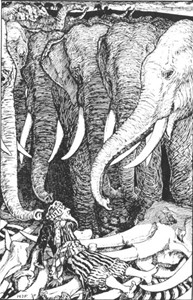 Humans and elephants have been intermingling since time immemorial, so it’s a little surprising to discover that we’re still not entirely sure how our pachyderm friends deal with their dead. Oh, we’re pretty sure the mourn, and they appear to cover their pals with leaves and sticks, too. But those elephant burial grounds mentioned in Arabian Nights? Our mammoth mammal friends aren’t quite that picky.
Humans and elephants have been intermingling since time immemorial, so it’s a little surprising to discover that we’re still not entirely sure how our pachyderm friends deal with their dead. Oh, we’re pretty sure the mourn, and they appear to cover their pals with leaves and sticks, too. But those elephant burial grounds mentioned in Arabian Nights? Our mammoth mammal friends aren’t quite that picky.
In the course of pursuing our recent Sri Lanka obsession, Microkhan has been reading James Emerson Tennent’s Ceylon, an 1860 account of life on the island nation. There’s an excellent (albeit dated) chapter on Ceylonese elephants, which includes a lengthy digression on burial. To Tennent’s consternation, even the island’s most dedicated naturalists could shed little light on the issue:
A European gentleman, who for thirty-six years without intermission has been living in the jungle, ascending to the summit of mountains in the prosecution of the trigonometrical survey, and penetrating valley in tracing roads and opening means of communication—one, too, who has made the habits of the wild elephant a subject of constant observation and study—has often expressed to me his astonishment that after seeing many thousands of living elephants in all possible situations, he had never yet found a single skeleton of a dead one, except of those which had fallen by the rifle.
It has been suggested that the bones of the elephant may be so porous and spongy as to disappear in consequence of early decomposition; but this remark would not apply to the grinders or to the tusks; besides which, the inference is at variance with the fact, that not only the horns and teeth, but entire skeletons of deer, are frequently found in the districts inhabited by the elephant.
The natives, to account for this popular belief, declare that the herd bury those of their companions who happen to perish. It is curious that this belief was current also among the Greeks of the Lower Empire; and PHILE, who wrote at Constantinople early in the fourteenth century, not only describes the younger elephants as tending to the wounded, but as burying their dead.
Alas, Manuel Philes’s De elephante does not appear to ever have been translated from the Greek. We’ll assign that task to Microkhan Jr., though perhaps not until he’s mastered at least a few words in English.


Ell // Apr 16, 2009 at 4:40 am
And when the elephants bury their dead they shed salty tears that feed little moths …
http://thenonist.com/index.php/thenonist/comments/3740/
http://www.newscientist.com/article/mg12817444.900-moths-with-a-taste-for-tears-insects-that-live-off-thetears-of-mammals-find-the-secretions-a-tasty-and-nutritious-food-the-mothswisely-favour-mildmannered-herbivores-as-their-victims-.html